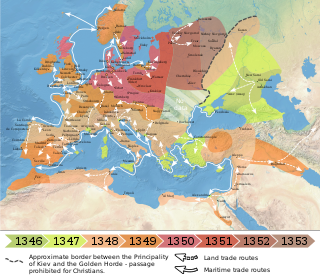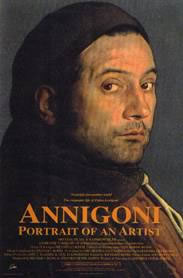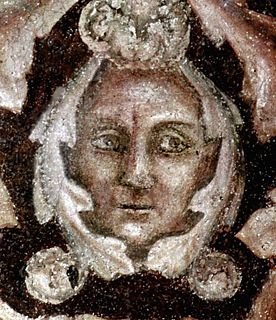
Giuliano Ughi della Cavallina, or Giuliano della Cavallina, (Cavallina di Mugello, 1483 – Bosco ai Frati, 1569) was a sixteenth-century Franciscan friar and writer. He spent his youth in his native village, La Cavallina, today a hamlet of some 2,500 inhabitants in the comune (municipality) of Barberino di Mugello, in the Province of Florence in the Italian region Tuscany, located about 25 km north of Florence. The hamlet today has a square named after its famous son: Piazza fra Giuliano Ughi, 50031 Cavallina, Italy

The comune is a basic administrative division in Italy, roughly equivalent to a township or municipality.
The Province of Florence was a province in the northeast of Tuscany region of Italy. The city or comune of Florence was both the capital of the Province of Florence, and of the Region of Tuscany. The territory of the province was the birthplace of the Italian Renaissance.

Italy, officially the Italian Republic, is a country in Southern Europe. Located in the middle of the Mediterranean Sea, Italy shares open land borders with France, Switzerland, Austria, Slovenia and the enclaved microstates San Marino and Vatican City. Italy covers an area of 301,340 km2 (116,350 sq mi) and has a largely temperate seasonal and Mediterranean climate. With around 61 million inhabitants, it is the fourth-most populous EU member state and the most populous country in Southern Europe.
Giuliano may have received the religious habit already in [1501], but in any case he became an Observant Franciscan at Prato in 1514. He later entered the community of the Convent of Bosco ai Frati, where he remained till his death and where he is buried.

Prato is a city and comune in Tuscany, Italy, the capital of the Province of Prato. The city is at the foot of Monte Retaia, elevation 768 metres (2,520 ft), the last peak in the Calvana chain. The lowest elevation in the comune is 32 metres (105 ft), near the Cascine di Tavola, and the highest is the peak of Monte Cantagrillo at 818 metres (2,684 ft). The Bisenzio, a tributary of the Arno, flows through it.

The Convent of Bosco ai Frati is located in the comune (municipality) of Scarperia e San Piero, in the midst of Turkey oak woods. The area is in the province of Florence in the Italian region Tuscany, and is situated about 25 kilometres northeast of Florence.
The convent and its extensive surrounding woods had been donated to Saint Francis di Assisi and had become a Franciscan friary in 1212. Having been abandoned on account of the Black Death, it was revived, rebuilt and embellished and restored to the Franciscans from 1420 by Cosimo de' Medici (the Elder).

The Black Death, also known as the Great Plague, the Black Plague, or the Plague, was one of the most devastating pandemics in human history, resulting in the deaths of an estimated 75 to 200 million people in Eurasia and peaking in Europe from 1347 to 1351. The bacterium Yersinia pestis, which results in several forms of plague, is believed to have been the cause. The Black Death was the first major European outbreak of plague, and the second plague pandemic. The plague created a number of religious, social and economic upheavals which had profound effects on the course of European history.

The Franciscans are a group of related mendicant religious orders within the Catholic Church, founded in 1209 by Saint Francis of Assisi. These orders include the Order of Friars Minor, the Order of Saint Clare, and the Third Order of Saint Francis. They adhere to the teachings and spiritual disciplines of the founder and of his main associates and followers, such as Clare of Assisi, Anthony of Padua, and Elizabeth of Hungary, among many others.

Cosimo di Giovanni de' Medici, called "the Elder" and posthumously "Father of the Fatherland", was an Italian banker and politician, the first member of the Medici political dynasty that served as de facto rulers of Florence during much of the Italian Renaissance. Despite his influence, his power was not absolute; Florence's legislative councils at times resisted his proposals throughout his life, and he was always viewed as primus inter pares rather than an autocrat. His power derived from his wealth as a banker, and he was a great patron of learning, the arts and architecture.
Giuliano was a writer whose main work is the Cronica di Firenze (Chronicle of Florence) which covers the years 1501 to 1546. Among other events, it furnishes details on the successful siege of Florence by imperial troops which returned the exiled Medici to power, and is written in the local dialect of the Mugello region.

The Siege of Florence took place from 24 October 1529 to 10 August 1530, at the end of the War of the League of Cognac. A large Imperial and Spanish army under Philibert of Châlon, Prince of Orange and Pier Maria III de' Rossi surrounded the city, and, after a siege of nearly ten months, captured it, overthrowing the Republic of Florence and installing Alessandro de' Medici as the ruler of the city.
He wrote at least three other works: the Vita della Beata Chiara Ubaldini, (Life of the Blessed Chiara Ubaldini), the biography of a local abbess, Relazione dell'origine e del progresso del Convento del Bosco (Account of the Origins and Development of the Convent of Bosco) and Relazione sui danni al Convento del Bosco ai Frati causati dal terremoto del 13 giugno 1542 (Account of the Damage to the Convent of Bosco ai Frati caused by the earthquake of 13 June 1542). The latter two are increasingly employed as a source by historians and seismologists. One manuscript of the Chronicle is conserved as Florence, Biblioteca Biomedica dell’Università degli Studi di Firenze, Mss. R. 210.4.









